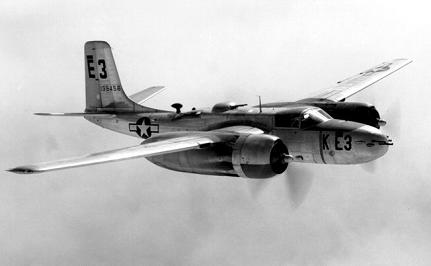![]() The Pacific War Online Encyclopedia
The Pacific War Online Encyclopedia
|
| Previous: A-20 Havoc, U.S. Medium Bomber | Table of Contents | Next: A-28 Hudson, U.S. Medium Bomber |

U.S. Air Force.
Via Wikipedia
Commons.
Douglas A-26B Invader
|
Crew |
2 | ||||
|
Dimensions |
51’3” by 50'8"”
by
18’3” 21.34m by 15.47m by 5.64m |
||||
|
Wing area |
540 square feet 50.2 square meters |
||||
|
Weight |
22,803-34,927 lbs 10,174-15,876 kg |
||||
|
Maximum speed |
355 mph at 15,000 feet 571 km/h at 4571 meters |
||||
| Cruise speed | 284
mph 457 km/h |
||||
|
Climb rate |
33 feet per second 10 m/s |
||||
|
Service ceiling |
22,100 feet 6736 meters |
||||
| 2 2000hp (1491 kW) Pratt & Whitney R-2800-79 Double Wasp 18-cylinder radial engines driving three bladed propellers | |||||
|
Armament |
6 to 22 nose 0.50
machine guns Ventral twin 0.50 machine gun turret Dorsal twin 0.50 machine gun turret |
||||
|
Bomb load |
4000 lbs (1800 kg) of bombs
internal 2000 lbs (900 kg) of bombs or rockets under the wings |
||||
|
Range |
1400 miles (2250 km) with bomb load | ||||
| Fuel |
1332 gallons (5042 liters) internal |
||||
|
Production |
|
||||
| Variants | The A-26C had a transparent nose and only two 0.50 nose machine guns. It was often fitted with radar. | ||||
The A-26 Invader came into service in 1944 and was the fastest U.S.
bomber of the war. It was derived
from the A-20,
but was even hotter and more heavily armed and armored, with 6 0.50 caliber nose machine
guns. In addition, the top turret could be locked forward
to contribute to strafing firepower. Some were modified in the field to
carry up to 22
machine
guns. With its heavy
gun
armament, it was a very potent strafer and proved particularly
effective in the
anti-shipping role. It
was also equipped with
rockets, but these
turned out to be unsuitable for low-level strafing attacks: The
fast-moving A-26 was almost on top of the target when the rockets hit,
and was
in serious danger from the debris kicked up by its own
attack.
The A-26 was slow to come into production because of
disputes over the correct nose armament configuration, which originally
was to include a 75mm nose gun.
A proposal to design a modular nose
that could be swapped for different configurations proved impractical.
The aircraft was later redesignated the B-26 (not to be
confused with the B-26 Marauder,
which had been phased out by then) and was still being manufactured as
late as 1963 for use in Vietnam.
Although the A-26 made its combat debut in New Guinea, only about 20% of A-26 crews were deployed to the Pacific.
References
The Pacific War Online Encyclopedia © 2007-2008 by Kent G. Budge. Index